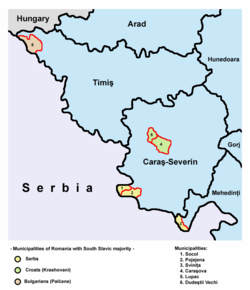This is an old revision of this page, as edited by 217.128.104.83 (talk) at 13:03, 29 April 2008 (→Language and religion). The present address (URL) is a permanent link to this revision, which may differ significantly from the current revision.
Revision as of 13:03, 29 April 2008 by 217.128.104.83 (talk) (→Language and religion)(diff) ← Previous revision | Latest revision (diff) | Newer revision → (diff) Ethnic group| Regions with significant populations | |
|---|---|
| Romania (Caraş-Severin County) | |
| Languages | |
| Torlakian (spoken); Croatian language (declared in census) | |
| Religion | |
| Predominantly Roman Catholic | |
| Related ethnic groups | |
| other Slavic peoples, especially South Slavs |
The Krashovani (Croatian and Serbian: Krašovani (Крашовани), Karašovani or Krašovanje, Karaševci and Koroševci; Romanian: Caraşoveni, Cârşoveni, Cotcoreţi or Cocoşi, Bulgarian: Крашовени, Krashoveni; also known in English as Krashovans) are a South Slavic people indigenous to Caraşova and other nearby locations in Caraş-Severin County within the Romanian Banat.
It is estimated that around 5,000 people compose the Krashovani community in Romania. At the 2002 census, only 207 persons identified as Krashovans at a national level. The vast majority identify today as Croatian.
Geography
Krashovani form a majority in two communes of Caraş-Severin County: Caraşova and Lupac.
According to the 2002 census in Romania, the population of the Caraşova commune comprised 84.60% Croats, 4.96% others (presumably Krashovan), 4.47% Roma, 4.41% Romanians, etc. The population of Lupac commune comprises 93.38% Croats, 5.32% Romanians, etc. The 79.75% of population of Caraşova municipality and 93.45% of population of Lupac municipality declared to speak Croatian as mother tongue in 2002 census.
Origin and history

Original Slavic settlements had existed in these regions before the Krashovan migration. Krashovani themselves are mostly descendants of the Torlakian inhabitants of what is today eastern Serbia, namely the region around the Timok River.
Some of the Krashovani originate from Turopolje region of present-day Croatia (they are being referred as Turopoljci). Because of the long-time influence of other Krashovani, who speak the Torlakian dialect, the original (Kajkavian) dialect of this group also became Torlakian. Other groups are supposedly Croats from the Franciscan province of Bosna Srebrena.
The Krashovani are also considered Bulgarians by some (mainly Bulgarian) scientists from the first half of the 20th century (such as G. Cibrus, M. Mladenov, K. Telbizov, and T. Balkanski). These claims are partially based on the fact that these and some other scientists consider the entire Torlakian-speaking Slavic population ethnically Bulgarian, just as others consider it ethnically Serbian. The question of whether the Torlakian dialect belongs to the eastern or western branches of South Slavic languages is also disputed, and it is often classified as a transitional dialect between the two.
Krashovani migration to Banat can be traced to the 1370s, when fleeing the Ottoman onslaught, they moved there from Timok region (at that time ruled by Bulgaria). The Catholic supremacy inside the Kingdom of Hungary (to which the Banat region belonged at the time) may account for their distinctiveness from the rest of the Torlakian-speaking population in present-day eastern Serbia.
According to the Austrian population census there were over 10,000 Krashovans in the Romanian Banat. In the 1847 census over 10,000 people declared as Carasovans. In 1896 the Austro-Hungarian census around 7,500 Krashovans were listed. The same was stated by the authorities of the Kingdom of Romania in 1940. Their number dropped to 2,775 in 1992.
Ever since the Romanian Revolution, the government of Romania has awarded special minority status and privileges to its ethnic Serb citizens. The Democratic Union of Serbs and Krashovani of Romania (Uniunea Democratică a Sârbilor si Caraşovenilor din România) was founded in 1989.
Language and religion

The dialect of the Krashovani is based on the Torlakian as traditionally spoken in the area of eastern and southern Serbia and in the Republic of Macedonia and Bulgaria, the Torlakian dialect of the Timok valley around Zaječar. Torlakian as a linguistic entity forms a part of the Balkan Linguistic Union; the Krashovani are the only speakers of a language - belonging to this union for having developed many shared features with the adjacent languages - which is detached from the main section. The population however, declare their language as Croatian, probably along the ethnic lines.
However, their religion has more recently set them apart from Eastern Orthodox Serbs in the Banat, despite the common language and a long history of solidarity (partly continued to this day through joint Serb-Krashovan organizations).
See also
- Minorities of Romania
- Caraşova
- Lupac
- Torlaks
- Torlakian dialect
- Croats of Romania
- Serbs of Romania
- Banat Bulgarians
References
- Template:Ro icon Recensământ 2002. Rezultate: Populaţia după etnie la recensământul din 2002; retrieved November 10, 2007
- Structura etno-demografică pe arii geografice. Caraşova, at the Ethnocultural Diversity Resource Center. Open Society Foundation Romania; retrieved November 10, 2007
- Structura etno-demografică pe arii geografice. Lupac, at the Ethnocultural Diversity Resource Center. Open Society Foundation Romania; retrieved November 10, 2007
- Spaţiul istoric şi etnic românesc, Vol.I, Editura Militară, Bucharest, 1992
External links
| Ethnic groups in Romania | |
|---|---|
| Dominant group | Romanians (16,792,868) |
| Officially recognised minorities |
|
| Non-recognized minorities |
|
| Historical ethnic groups |
|
| Immigrant groups |
|
| |